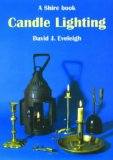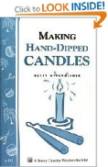-
History of:
- Resources about:
- More:
- Baby walkers
- Bakehouses
- Bed warmers
- Beer, ale mullers
- Besoms, broom-making
- Box, cabinet, and press beds
- Butter crocks, coolers
- Candle snuffers, tallow
- Clothes horses, airers
- Cooking on a peat fire
- Drying grounds
- Enamel cookware
- Fireplaces
- Irons for frills & ruffles
- Knitting sheaths, belts
- Laundry starch
- Log cabin beds
- Lye and chamber-lye
- Mangles
- Marseilles quilts
- Medieval beds
- Rag rugs
- Rushlights, dips & nips
- Straw mattresses
- Sugar cutters - nips & tongs
- Tablecloths
- Tinderboxes
- Washing bats and beetles
- Washing dollies
- List of all articles
Subscribe to RSS feed or get email updates.

Candle Lighting
from Amazon.com
or Amazon UK
Much waste of tallow is occasioned in many families that can ill afford it, by careless and slovenly habits. Such as, carrying a candle aslant, or not properly fixing it in the candlestick with paper -- (if it is but a pound in a year that is to wasted, it does no good at all spilt on the floor) -- or suffering a lighted candle to stand in the draft of an open door (or broken window; in which situation it will burn out in half the time; -- or, in the day time, instead of putting the pieces of candle in the box, standing them in the candlestick in the influence of the fire or sun -- or instead of sticking the small pieces upon a saveall, suffering them to burn away in the socket. I have been told that poor people cannot afford such things as candle-boxes and savealls. It would be more reasonable to say, they cannot afford to do without them.
Esther Copley, Cottage Comforts, 1825

Making Hand-Dipped Candles: Storey Country Wisdom
from Amazon.com
or Amazon UK
Tallow candles & Snuffers
Candle wicks dipped in beef or mutton tallow
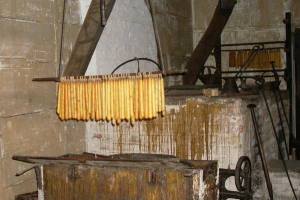 Tallow
candles don't sound good to us - a sooty wick burning in animal fat - but for centuries
they were a reliable way of having some light after dark. In a small home the fire
in the hearth was often a major source of light, but you could brighten up different
areas, and even have a light you could carry from place to place if you had a candle
in a portable holder.
Tallow
candles don't sound good to us - a sooty wick burning in animal fat - but for centuries
they were a reliable way of having some light after dark. In a small home the fire
in the hearth was often a major source of light, but you could brighten up different
areas, and even have a light you could carry from place to place if you had a candle
in a portable holder.
If you were making the candles yourself, you needed a pan of hot tallow. This is the hard pale fat from cows or sheep, and it was available in different qualities according to how much it had been processed by the tallow boiler. It could be pale creamy fat, not too smelly when the candle was alight, or full of impurities. Occasionally people made use of the worst fat of all - lard, or pig's fat - said to stink when burning.
The quality of a candle depended on the fat that was used. The better the quality of the fat, the firmer and less offensive was the candle. New England settlers were fortunate to discover that the waxy berries from the bayberry bush made very pleasant candles. ...Peter Kalm wrote...in 1748...There is a plant here from which they make ...wax...Candles of this do not easily bend, nor melt in summer...nor do they cause any smoke, but yield rather an agreeable smell when they are extinguished."
J and D Volo, Daily Life on the Old Colonial Frontier, 2002
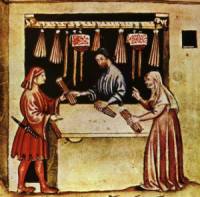 Next
you measured out thread for the candle wicks. By dipping the wick repeatedly into
the melted tallow you can build up a candle. Each time you dip, the candle gets
a new layer of fat. Pull it out into the cool air to harden, then dip again until
the candle seems the right thickness. Hanging a group of threads over a rod means
you can dip plenty in one go and make several pairs of candles at once. The rod
was called a broach when used by a professional tallow chandler or candle-maker.
In the reconstructed 19th century candle-making workshop (photo top right) you can
see a well-organised operation with a tallow trough, and a dipping frame for lowering
and raising a batch of candles.
Next
you measured out thread for the candle wicks. By dipping the wick repeatedly into
the melted tallow you can build up a candle. Each time you dip, the candle gets
a new layer of fat. Pull it out into the cool air to harden, then dip again until
the candle seems the right thickness. Hanging a group of threads over a rod means
you can dip plenty in one go and make several pairs of candles at once. The rod
was called a broach when used by a professional tallow chandler or candle-maker.
In the reconstructed 19th century candle-making workshop (photo top right) you can
see a well-organised operation with a tallow trough, and a dipping frame for lowering
and raising a batch of candles.
At home you might just dip a few threads strung over a stick but the basic idea was the same. Or you could buy ready-made candles. The picture to the left shows a candle seller and customers at a stall in 14th century Italy.
Snuffers, snuffs and wicks
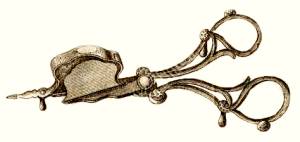 The wicks were made from twisted
threads of flax, cotton, or hemp, and didn't burn nearly as well as our modern wicks.
Trimming the wick to get rid of "candle snuffs" was an important part of keeping
your candle burning well. If you didn't attend to it, the candle could get too hot,
melt too much fat and send it streaming wastefully and messily down the sides -
known as guttering. Smoking and excessive smell could also be improved by careful
trimming.
The wicks were made from twisted
threads of flax, cotton, or hemp, and didn't burn nearly as well as our modern wicks.
Trimming the wick to get rid of "candle snuffs" was an important part of keeping
your candle burning well. If you didn't attend to it, the candle could get too hot,
melt too much fat and send it streaming wastefully and messily down the sides -
known as guttering. Smoking and excessive smell could also be improved by careful
trimming.
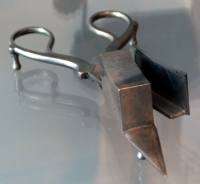 Candle snuffers were not primarily for
extinguishing the candle. Snuffers were like scissors (or nippers) for cutting off
excess sooty thread. A sharp point was useful for spearing any scraps of burnt wick
that fell into the hot tallow. The snuffers often had a box to catch those clipped
threads - the "snuffs". I guess you had to be experienced to make the
trimmings fall neatly into the box! Snuffers were sometimes called snuffer boxes
or box snuffers.
Candle snuffers were not primarily for
extinguishing the candle. Snuffers were like scissors (or nippers) for cutting off
excess sooty thread. A sharp point was useful for spearing any scraps of burnt wick
that fell into the hot tallow. The snuffers often had a box to catch those clipped
threads - the "snuffs". I guess you had to be experienced to make the
trimmings fall neatly into the box! Snuffers were sometimes called snuffer boxes
or box snuffers.
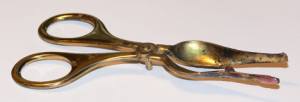 A snuff-pan, dish, or tray to lay greasy snuffers on was useful
too. Sometimes the snuffers were kept upright in a snuff-stand. Conical extinguishers
to put the flame out are still used today. The cap fits over the top of the candle
and stops air from keeping the flame burning. They can be on any length of handle
and are useful for putting out hard-to-reach candles. (See photo at bottom of page.)
We often call them snuffers nowadays.
A snuff-pan, dish, or tray to lay greasy snuffers on was useful
too. Sometimes the snuffers were kept upright in a snuff-stand. Conical extinguishers
to put the flame out are still used today. The cap fits over the top of the candle
and stops air from keeping the flame burning. They can be on any length of handle
and are useful for putting out hard-to-reach candles. (See photo at bottom of page.)
We often call them snuffers nowadays.
England 1788:
"Bought and paid for a Dozen of candles 10 in the pound...8s 6d."
...candles were usually sold by the pound. There were three principal sizes, eights, of which eight made a pound, tens,...and twelves, which were the least substantial...
David Eveleigh, Candle Lighting (Shire Library), 2008
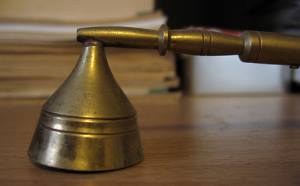 Rushlights
made from rushes dipped in grease were like the
simpler kind of tallow dip, but even cheaper since there was no need to
spin or buy thread for the wick. Other early lighting included torches of flaming
oily wood, lamps containing animal fat or oil, or scarce and very expensive
beeswax candles. Tallow candles could also be made in moulds to get a regular size
and shape for those who could afford an upmarket candle made of the most refined
tallow. The moulds were pewter or tin-lined iron.
Rushlights
made from rushes dipped in grease were like the
simpler kind of tallow dip, but even cheaper since there was no need to
spin or buy thread for the wick. Other early lighting included torches of flaming
oily wood, lamps containing animal fat or oil, or scarce and very expensive
beeswax candles. Tallow candles could also be made in moulds to get a regular size
and shape for those who could afford an upmarket candle made of the most refined
tallow. The moulds were pewter or tin-lined iron.
Braiding thread for wicks was one of the great discoveries of the 19th century. The braiding encourages the wick to curl back into the flame as the surrounding tallow burns down. This means more wick is burnt, and less charred, sooty "snuff" needs tidying up. The 1800s also saw great steps forward with tallow. Stearin could be extracted from it for better quality candles, or tallow could be mixed with other oils.
See also:
Rushlights, rush dips and nips
English National Trust history of lighting by tallow candles
Make your own tallow - added March 2012
Early American candle holders
 18 April 2009
18 April 2009
You may like our new sister site Home Things Past where you'll find articles about antiques, vintage kitchen stuff, crafts, and other things to do with home life in the past. There's space for comments and discussion too. Please do take a look and add your thoughts. (Comments don't appear instantly.)
For sources please refer to the books page, and/or the excerpts quoted on the pages of this website, and note that many links lead to museum sites. Feel free to ask if you're looking for a specific reference - feedback is always welcome anyway. Unfortunately, it's not possible to help you with queries about prices or valuation.


